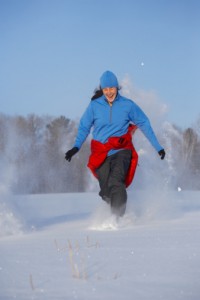 Does the winter put a damper on your training? Or, when the mercury starts to drop, do you suck it up and go running in the cold anyway?
Does the winter put a damper on your training? Or, when the mercury starts to drop, do you suck it up and go running in the cold anyway?
Where we live in the Colorado mountains, it gets chilly. Not that cold, my Minnesota-born wife, Heather, could attest, but cold enough. We’re below freezing our fair share during the winter months.
What about running in the cold, then?
No trouble. I run at home year-round, did a few hundred miles in freezing rain and snow on the east coast a few years ago, and competed in the Iditafoot 100-mile race in Alaska with my buddy Mark Macy, a snowshoe champion and ice climber—which I mention only so you know we both know something about low temps. He and I agree the key is simple …
Basically, listen to your mother. Dress for the weather.
“Put on a hat and gloves.” Believe me, Mom knew what she was talking about. Among all the things you can do to keep warm, covering your head and hands ranks as the most important when running in the cold. Because of the large surface area of these extremities, you can lose body heat faster from uncovered head and hands than most anywhere else on your body.
“Wear layers—long underwear, if you need it.” Rather than pulling on one heavy piece of clothing, you’ll want several light to middle-weight layers of clothing so that you can take off pieces as you warm up. Mark and I have discussed this: put on just enough clothes but maintain a bit of a chill so your body can cool off, and you can actually work harder in the colder weather. True, with layers you’ll wind up with something tied around your waist, maybe a piece left by the side of the road that you’ll need to pick up later, but this gives you flexibility as the temperature outside changes and your body warms up.
“You need some warm socks.” Wear your favorite shoes, but during the colder months, switch to a warmer sock. As your feet sweat in the sock, that breathable mesh in most shoes nowadays will help the moisture evaporate while the sock keeps you warm. Don’t overdo it, though, meaning you don’t need several pairs on or a crazy-thick hiking sock. Running in the cold, your feet stay naturally warm because of the constant motion and exertion.
“Natural fibers are best.” It’s not that easy to find unadulterated silk (the best for wicking and warmth) or wool these days, but there are some good alternatives, too. Polypropylene and SmartWool (with some polyester + wool) socks and other items do a good job of keeping you warm and reasonably dry, and the next best thing to wool or silk underlayers is mid-weight Capilene®. It’s polyester but provides a toasty, thin underlayer that wicks and is quick-drying. It’s also recyclable and made with at least 50% recycled content. Also kind of amazing: it has excellent odor-control. I wore my Capilene shirt so much when we were in Ohio, Pennsylvania, New Jersey, and New York during the 2008 transcon that it got washed only once in a week and a half—and I don’t think it ever smelled bad, even after 60 miles a day, every day.
Following are some clothing guidelines for running in the cold:
- 60 degrees or warmer: stick with shorts and a short-sleeve shirt. Even if you’re cool at the outset, you’ll warm up quickly enough, usually within 10 to 15 minutes. Still cold? Good news: you can probably work harder.
- 40s and 50s: wear a thin to medium-weight layer under your running clothes. Wear longer pants, too, either a medium-weight pant over shorts or tights or medium-heavy running pants or tights on their own. In the 50s, you probably don’t need gloves, and you could do with a light runner’s cap, but heading down into the mid- to low 40s, you’ll want to at least start with something to cover your ears and your hands.
- 20s and 30s: Add more articles of clothing—more layers—instead of one very heavy layer. Don’t forget to follow mom’s advice: it’s now officially cold outside, and you need to cover your head and hands.
- With wind: You’ll need some kind of shell to further protect you from the elements. Breathability is still important, so a jacket or pants of light nylon wind-breaker fabric works well; I’m partial to fleece for just about any condition but hard rain.
Beyond that, it takes more of the same, calling for more layers, warmer gloves, a warmer cap. You might want to take up skiing or some other winter sport for cross-training when it gets into the teens or below. Personally, I used to love to run in the new snow, especially in the woods where I could break trail, be the first to lay tracks. But here’s something you probably never expected me to say: sometimes it’s better just to head for some brandy and a book by the fire.
Sometimes, it’s okay to forget running in the cold and decide to get warm, instead.
Or you could do what Heather and I decided to do this year: we cleared out and headed for Lake Havasu. Temps here today? Low sixties. All I need is my shorts and a shirt.










Hi Marshall. what about exposed skin…..wouldn’t you say Dermatone is a perfect fit? 🙂
Good point! Yes, Dermatone is a perfect fit and a dab of Dermatone Lips and Face protector will keep your nose, lips and the inside of your nose from drying out. It also is 23 SPF so the reflection of the sun radiating up from snow won’t be a problem (it’s common for the bottom and inside of the nose to burn in sun and snow combination conditions). Makes a good stocking stuffer, too.
Also, I neglected to mention: a “buff” is perfect protection against the elements. (See one of these and some other good winter gear at http://outside-blog.away.com/blog/2010/12/the-gear-junkie-winter-gear-checklist-bike-and-run.html.) You can draw it up over the nose, and the air you breath will be moisturized. This can be troublesome when you’re running in the cold temperatures where the condensation may create a frozen blockage. If that happens, a lightweight balaklava with an opening below the nosepiece works great.
Marshall, I am a NYC area runner so the cold has arrived (upper 20s during this morning’s run). I agree, hat and gloves are #1 on my list and lots of layers. I also prefer a light jacket/shell with a zipper when it gets into the 30’s and below. Rather than pealing off layers I partially unzip the front when I get hot say working hard up a hill and zip up when I get cold on the way back down. Peace EricG
This is a funny article. Like your wife I am from Minnesota. I still wear shorts at 20+.
I have run as cold as -22 Fahrenheit plus windchill this year. At that temp it’s important to cover your skin to avoid frostbite. Vaseline or glide work great. It’s also important to keep a wicking layer and not to overdress. Sweat is your enemy. If you get wet you will freeze.
Another Minnesotan here. I’d overheat wearing that much. In the upper 20’s, I still need to take off my hat and gloves after a mile or so to keep from overheating. Feels great running in the cold! I wear shorts down to about 30F, below that, I’ll add on some tights.
What do you guys think for snow/ice? Yaktrax or just some trail shoes? I picked up some gaiters for this year to try and keep the snow outta there 😉
I think Yaktrax work great, and there are others too, http://tinyurl.com/bcvlqcs . If you’re on snowpack and icy roads, opt for these grips as opposed to even aggressive running shoes, as those will not do the job!
p.s. I love the buff too. I often wear that as sort of a headband so the heat can still escape from my head, but keep my ears warm.
Hi Marshall,
This article really caught my attention as I have been having problem doing ultra trail run in cold weather (not wintery cold with snow, but ranges between 5C (40F) – 15C (60F) depending on the time of the day, elevation and wind condition. Because of that, I DNFed one 100km, and completed one 100miles with very close call to DNF as well!
I couldn’t quite figure how the layering of clothes despite reading from the website, I wore a long-sleeve thermal compression (2XU) and cover myself with IceBreaker’s Wool top (206s), but what happened during the race was I sweated during the run, and the wetness didnt evaporate away from the Wool top, things get even worse on my back, as I was carrying hydration bag, and it prevented the escape of sweat vapor. And everytime when I stopped for refuelling or when the wind blew, it gave me serious chill. I would want to take the Wool top off, but then it would be too cold (or I did feel that) with single layer.
Any advice?
Thanks!
Shine, I’m confident that the IceBreaker’s wool top wasn’t the problem. I personally do not like compression clothing and stick with loose layering, as I believe that it allows the body to cool more effectively. I would use two loose-fitting wool layers and a very light Gore-Tex or similar layer to break the wind if needed. I wear Gore-Tex only when it is cold and windy, and for drizzle or rain as in all other cases, it doesn’t really breathe that well. If there isn’t wind or moderate or more rain is involved, Patagonia Capilene or a light fleece works well for an overlayer…you can get these in different weights–and be sure to get something that zips way down or completely in the front for venting. Some even have armpit zip vents, which are great, too. Keep yourself slightly chilly and avoid overdressing. Once you are wet, you’re dead in the water (excuse the pun).
As far as a hydration system, I go with a belt and that will help you avoid sweating because of a backpack hydration system. However, if you insist on a backpack hydration system, take a look at the Deuter Airlite that holds up to 100 oz., because the air suspension allows airflow around the back. This is the pack system that we used in Death Valley in 125-degree heat, and it worked brilliantly: http://www.rei.com/product/833393/deuter-race-air-lite-hydration-pack-100-fl-oz,-neon/titan?preferredSku=8333930001&cm_mmc=cse_froogle-_-pla-_-product-_-8333930001&mr:referralID=1a69f872-4a0d-11e2-97b3-001b2166becc I hope this information helps!